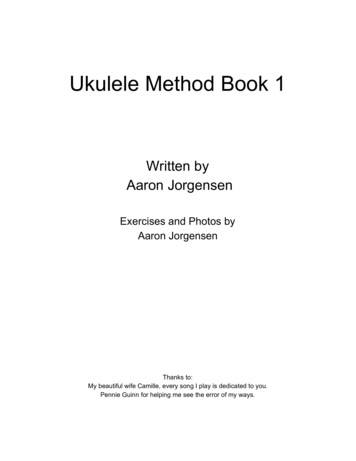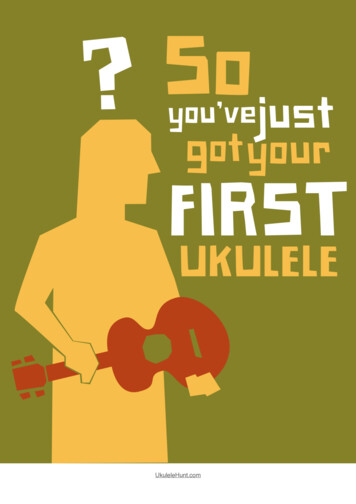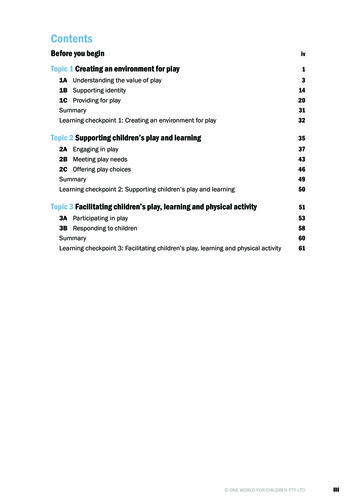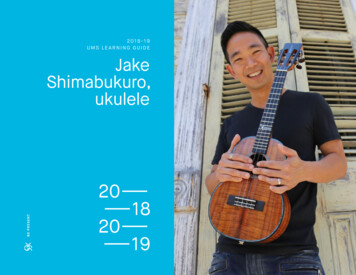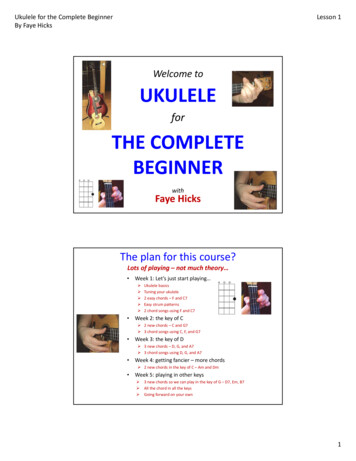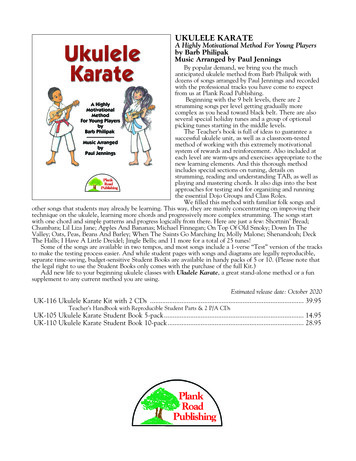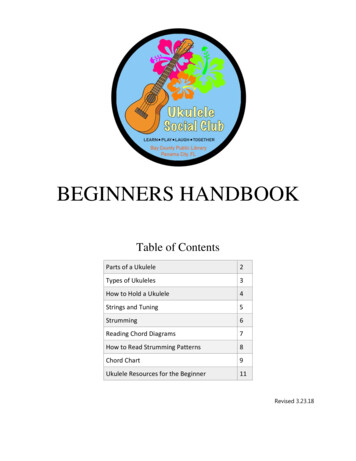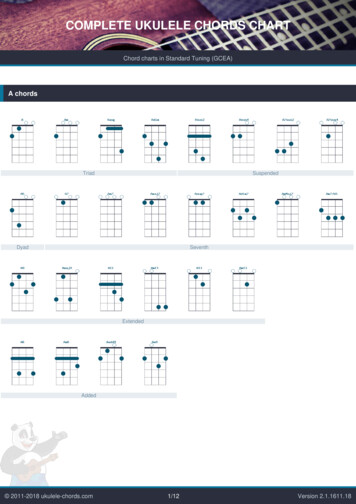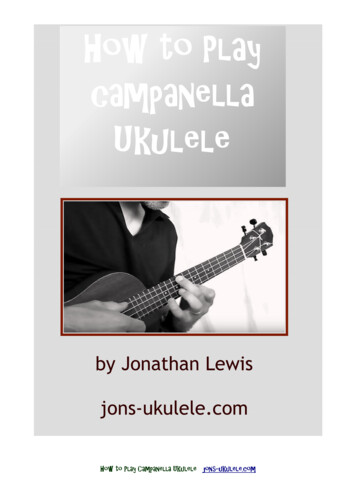
Transcription
How to PlaycampanellaUkuleleby Jonathan Lewisjons-ukulele.comHow to Play Campanella Ukulele jons-ukulele.com
ContentsIntroduction1. What is campanella?2. Right Hand techniques andexercises3. Campanella scales- Different ways to play C major- Other Scales4. Practice Tunes- London Bridge is Falling Down- Lovely Joan- The Plains of Waterloo- Ode to Joy- Jon's Jig5. More resourcesHow to Play Campanella Ukulele jons-ukulele.com
IntroductionWelcome to this short introduction to campanella ukulele. I've written it forpeople (hopefully like you) who have been playing ukulele for a while but wouldlike perhaps to do more than just strumming chords.People always smile when I tell them that I play ukulele, which is goodbecause it's a fun instrument that many associate with good times, hula girls, andmusic hall entertainers like George Formby. But I'm on a mission to show the worldthat beautiful – and sophisticated – music can be made on this little instrument andI hope you'll join me. Campanella picking is for me what the makes the ukulele sospecial.You'll learn some scales and easy tunes. The scales are to help you learn thefretboard and to show you that you'll need more than one place to play the samenotes when working out how to play tunes the campanella way. Feel free to skipstraight to the tunes if you want. I was never a good student when it came to theoryso I won't be upset!To use this guide, you should already be able to : Tune your ukulele – campanella needs accurate tuning or it will sound awful!Digital tuners are pretty cheap these days and there are plenty of free appsfor phones and tablets too (I use Pitch Lab). Play a few chords (just the basic, first position chords, you'll start to learn thefretboard here). Read tablature. It's a lot easier than standard music notation and is better forfingerstyle and campanella because it clearly indicates where to put yourfingers. You can find plenty of tutorials on the Internet. Play with your fingernails! You can play without them, but the sound isclearer, louder and crisper (is that a word?) if you have nails. Not too long,either, otherwise they'll be breaking all the time.How to Play Campanella Ukulele jons-ukulele.com
Be willing to learn things for yourself through patience and perseverance. Idon't make videos where I tell you things like, “OK now take your secondfinger and put it on the first string, third fret like this” and keep doing it for awhole song. If you want to get good at an instrument, there will come a timewhen your teacher can't mollycoddle you any more. Your musicianship willdevelop faster if you work from the tab and decide for yourself which is thebest finger to use (left and right hand). As you will see from the scale practicein this book there is never only one way to play campanella so be big girl orboy and develop some autonomy. You'll thank me for this advice in years tocome.If you are a complete beginner, please head over to ukulelehunt.com anddownload the free e-book to get you started. Or consider buying Ukulele forDummies – it's the comprehensive guide to all things ukulele. Come back to thisguide when you can play a few songs. You'll find a list of other great resources atthe end of the book.The tabs in this guide were made with Guitar Pro 6 – possibly the besttab/music editor available. You might consider getting this excellent software soyou can arrange your own pieces and hear how they sound, or experiment with thetunes here. When I'm arranging pieces in the campanella style, I often start bysimply copying the tune in standard notation into GP6 then I start looking for theideal fingering to transform it into campanella.How to Play Campanella Ukulele jons-ukulele.com
About MeI've been a hobby guitarist for more than for thirty-five years and fingerstylewas always my favourite way of playing. I'd never given any thought to ukuleles – Iconsidered them to be just toy guitars for kids (not knowing anything aboutHawaiian music). But when a friend asked me to tune the ukulele she had boughtfor her son, I discovered this peculiar way of tuning it – re-entrant, or high-G. Thiswas totally fascinating to me – I quickly figured out that you could get cool harplike sounds by playing all of the strings one after the other. I had been using opentunings on the guitar so I already knew the 'harping' technique used by some of myfavourite players, like Pierre Bensusan and John Renbourn but never knew just howpretty it could sound on this miniature guitar!Moving on a few years and I finally get myself a uke – I wanted somethingsmall enough to take on vacation with me – and thanks to YouTube I find sometutorials by Tim Keough – ukuleletim is his username. There I learn that this 'harp'technique is called 'campanella', literally, 'little bell'. After reading this short bookand trying some of the exercises, I recommend you head over to his page and trysome of the arpeggio studies Tim wrote, they're fantastic! So that's me hooked onukulele and campanella is pretty much the only thing I do these days.I hope you will enjoy the book and learning some tunes. Please feel free tosend me your questions and comments, and stay in touch with me via my YouTubechannel or website.warning:In Britain, where I come from, ukulele is usually pronounced 'yoo kuh lay lee'. I understand thatperhaps 'ookoolaylee' is a more authentic pronunciation but it doesn't sound natural with myBritish accent. So don't be surprised to see the indefinite article, 'a' – “a ukulele” – and not 'anukulele'Please subscribe to my YouTube Channel for more Campanella fingerpicking videos and tutorialsHow to Play Campanella Ukulele jons-ukulele.com
What exactly is campanella?The word means "little bell" and that's the effect we're trying to get - whenyou hear church bells, one doesn't stop ringing before the next one starts - they allring at the same time. The same for a harp. A harp doesn't have a neck where youcan put your fingers to change the pitch of a string, so one string, one note. Socampanella picking means avoiding playing two notes on the same string wheneverpossible, taking advantage of the re-entrant tuning (where the first and fourthstrings are only one tone – two frets – apart ). Using open strings as much as youcan and alternating between strings rather than playing successive notes on thesame string really does make the uke sound like a little harp.Arranging tunes in campanella is challenging, but ukulele re-entrant tuning(high G) makes it possible. Most of the traditional tunes I've uploaded were firstlearned on other instruments (guitar, mandolin, whistle) so the first thing I do isfigure out the tune on the uke anywhere (i.e. not campanella), then when I'm happythat the tune is accurate, I try to look for different ways to play it avoiding playingtwo notes on the same string.Wanna hear it what it sounds like?Play a C major scale the “normal” way, like this: (use whatever fingers youlike to pick, we'll get to right-hand techniques later.Notice that we move up the scale in the conventional, linear way, moving up thestrings one at a time while playing two or three notes on each string. When youchange note on the same string you obviously have to stop the sound of theprevious sound. Not so with campanella.How to Play Campanella Ukulele jons-ukulele.com
Now play it the campanella way. Careful, you have to go both up and down thestrings:Sounds better, doesn't it? That's because with the exception of the first two notes,C and D, which you can only play on the C string, you can always hear the previousnote. There is a slight dissonance, but rather than being unpleasant, it makes youthink of harps or bells – and that can be very satisfying.How to Play Campanella Ukulele jons-ukulele.com
Right Hand Practice forCampanella PickingThe most important for campanella is to get that right hand moving. If you'reonly used to strumming, it's time to free up your fingers and thumb and start usingall of them (well, not so much your pinky, but all the others). If you already knowhow to finger pick, you probably won't need to do these exercises, just skip to thescales and tunes later in the book.In guitar music, we use numbers for the left hand, (1,2,3,4) and letters for the righthand. These come from Spanish:P (pulgar) : ThumbI (indice) : IndexM (medio) : MiddleA (anular) : RingSo you will see the letters next to the note on the standard notation, like this:How to Play Campanella Ukulele jons-ukulele.com
Exercise 1.Start by placing your thumb on the fourth string (that's the one nearest yourchin), your index on the third, your middle finger on the second and your ringfinger on the first (nearest your feet), like thisNow play each string one after the other starting with your thumb (p)Do it over and over again until it starts to feel natural. When you can do itnaturally, choose some other chords to play and practice those. Now you've abetter a way to play some of your favorite songs! Playing chords this way isn'ttechnically campanella, but this is how you start.How to Play Campanella Ukulele jons-ukulele.com
Exercise 2Now, perhaps more importantly, we're going to learn the alternating patternthat you've heard millions of times in songs with acoustic guitar. The difference isthat with a high G ukulele, the thumb isn't playing a bassline, it's an essential partof the melody. This is one reason many ukers shy away from campanella – they feelthat fingerstyle must have a melody and an accompanying bassline. But anyonewho has heard pieces by Bach for solo violin and cello will know that great musiccan be made with just four strings!It's good to be flexible with your picking – the previous exercise rigidly sticksto a one string, one finger pattern but that's not always possible or desirable. So trythis with the same G major chord (and a F add 9):Try doing the same thing with songs you already know. If you'd like to do evenmore fingerpicking exercises, I made a video of different fingerstyle techniquesusing the same chord progression. There are some classical techniques that havenothing to do with campanella, but any practice is good practice!paste this link in your browser if the videowon't open: http://bit.ly/2dHWYADHow to Play Campanella Ukulele jons-ukulele.com
Scale Practice1. Seven Ways to Play a C major ScaleI should say “seven ways to play the top half of a C major scale” - because thefirst four notes are always played the same way. The first two, C and D, are onlypossible on the third string as they are lower than all the notes possible on theother strings. Then, to make the scale campanella we can play the E on the secondstring, open then the F back on the third string, fifth fret.By learning all the possible variations for the other notes, though, you will start tolearn the notes in all positions on the fretboard and understand better how tunesare arranged in the campanella style. They are certainly not equal in terms ofplayability, practicality or musicality (no.4 is definitely the best way) but they couldall come in handy when trying to find the best campanella fingering, so work yourway through them, up and down as shown in the video.paste this link in your browser if thevideo doesn't open:https://youtu.be/qS3x3Ukb v4How to Play Campanella Ukulele jons-ukulele.com
1. You will need to make a barre (cover all the strings across the second fret) forthis one.2. A bit better, here we have a couple more open strings3. B is moved to the second string, seventh fret4. That's more like it – the most ear-pleasing way to play the scale!How to Play Campanella Ukulele jons-ukulele.com
5. Here we swap the positions of B and (high) C, this can be useful when the sametwo notes repeat – you can avoid playing them in the same place by alternatingwith the previous positions.6. B and C move up to the 11th and 8th frets respectively. Good to have this optionsometimes.7. The high C is on the third string. I like to play harmonics instead of fretting thenote because the uke's neck is short so fretted notes this high up have very littlesustain. Play the harmonic by touching (not pressing down) the string directlyabove the 12th fret and pluck the string as you would normally with your righthand.How to Play Campanella Ukulele jons-ukulele.com
More ScalesPaste this link into your browser if thevideo won't open:https://youtu.be/ddheQRRnTkIA minorA minor is the Aeolian mode of C major – it has all the same notes, just played in adifferent order. When you start with the sixth note of any major scale, it becomesminor. That's because a minor scale is identified by the third note – it's three semitones (frets) higher than the root. So A major would be A B C#, and A minor is A B C,just as in the C major scale.For the G and A on the 12th fret, it's easier (and nicer) to play harmonics. Otherwise,you'll have to make a barre with your little finger (pinky). Tricky, but doable withpractice. Notice too, that when descending, it's easier to play the D on the fourthstring, 10th fret rather than the first string; 5th fret.Or you could play it like this (a bit awkward but at least you're really getting toknow the fretboard!) - you'll need to make a barre on the 7 th fret:How to Play Campanella Ukulele jons-ukulele.com
G major: high up the neck! It's a bit unnatural to jump from open strings up to theeleventh fret, but can be very useful in campanella picking.E minor : The relative minor of G major, starting with the open E string. Barre onthe 5th fret:D majorB minor: relative minor of D majorThis is not a complete scale but a pretty run in Bm which is reminiscent of a Celticharp. I've indicated the left hand fingering – notice that it's just like holding downa chord with your little finger having to move a couple of times:How to Play Campanella Ukulele jons-ukulele.com
F majorYou could change the root from second string, 1st fret to third string, 5th fret. Thatwould make it a little easier and maybe smoother but I still prefer the sound of theF on the 1st fret.D minor : relative minor of F majorG minorthis is the relative minor of B . I've not tabbed out the scale of B because you havethe notes here! Sorry for my laziness, you could try working it out yourself. Here's athing though: a lot of guitarists generally hate these keys with flats because therefingerings are usually very tiring on the left hand (loads of barre chords). But I likearranging in F and B on the ukulele – it can give a very sweet campanella sound.How to Play Campanella Ukulele jons-ukulele.com
Some Tunes to Learn!London Bridge is Falling downLet's start with an easy tune which Ihope you already know (not sure if it'sas well-known in the States). I've putthe right-hand fingering that I use butlike I've said, it's up to you to find away playing that suits you best.Paste this link if the video won't open:https://youtu.be/t2XCu6js4EQHow to Play Campanella Ukulele jons-ukulele.com
Lovely JoanThis English song is in the Dorian mode.For each scale, there are seven modes, onefor each note. The Dorian mode is themode that starts (and finishes) on thesecond note of the scale and is verycommon in Celtic music. To get a feel forit, try strumming the chords D minor (thesecond chord in the family of C major)then change to C major. Lots of Irish tuneshave this kind of chord change with a few embellishments here and there.Paste this link in your browser if the video won't open:https://youtu.be/W1YU4u-oZ5UHow to Play Campanella Ukulele jons-ukulele.com
The Plains of WaterlooYou can see that I've arranged it the key of C (there are no sharp or flat signs in thekey signature). But there are plenty of F sharps and the tune starts with a G, so is itMixolydian mode? Not really because there are F naturals too. Then it ends with aD, so is it Dorian mode? The guitarist Martin Simpson says that this tune shows howsophisticated traditional music can be – musicologists would never believe that apeasant could write a tune like this. I don't agree. I think that ordinary people canwrite beautiful music exactly because they know nothing about music theory andare thus unrestrained by rules and conventions. It's a really pretty tune, you'll see!Paste this link in your browser if the video won't open:https://youtu.be/X677qXkO6JQHow to Play Campanella Ukulele jons-ukulele.com
The Plains of WaterlooHow to Play Campanella Ukulele jons-ukulele.com
The Plains of Waterloo (cont.)How to Play Campanella Ukulele jons-ukulele.com
Ode To JoyTry this easy classical piece,Beethoven's Ode To Joy. To increasesustain and maintain the campanellavoicing, we're going to play Fs on thesecond string, first fret and the thirdstring, fifth fret, and As on the firststring, open and the second string.This is a good piece to build up yourspeed – once you've got the hang of it,practice playing it faster and faster.Paste this link in your browser if the video won't open:https://youtu.be/X0utk gAc6EHow to Play Campanella Ukulele jons-ukulele.com
Ode to Joy (Cont.)How to Play Campanella Ukulele jons-ukulele.com
Jon's JigNow for something with a Celtic flavour. I wrote this tune more as an exercise morethan anything else. It gives you an idea of some of the shapes and patterns that Iregularly use. The trickiest part of this tune is in the second part when you have toplay a high C and G on the twelfth fret – I make a barre with my little finger whichis a bit awkward. You could replace these notes with open harmonics to make it alittle easier.Copy and paste this link in yourbrowser if the video won't open :https://youtu.be/qwow76Zsr6YHow to Play Campanella Ukulele jons-ukulele.com
Jon's Jig (cont.)How to Play Campanella Ukulele jons-ukulele.com
Jon's Celtic Tunes Collection35 TunesBuy Now!Arranged forCampanella Fingerstyle UkuleleCheck out the tunes on my YouTube ChannelJigs!Reels!Polkas!The KeshJenny's ChickensDennis Murphy'sSaddle the PonyThe Ships are SailingJohn Ryan'sThe Humours of GlendartDrowsy MaggieHornpipes!The Blarney PilgrimThe Silver SpearChief O'Neill's FavouriteThe Mug of Brown AleThe Maid Behind the BarThe Factory SmokeThe Exile's JigThe Wind that Shakes the BarleyRoxburgh CastleThe Frieze BreechesCooley'sThe Silk HandkerchiefDingle RegattaSaint Anne's ReelThe Heather GlenMorrison'sSweeney's ButtermilkBanish MisfortuneJackie Coleman'sThe Monaghan JigO'Carolan!Brian O'LynnPlanxty HewlettThe Walls of LiscarollLoftus JonesTripping up the StairsCaptain O'KaneThe Hag with the MoneyBonus!American Tunes!Arkansas TravelerSoldier's JoyDevil in a HaystackGrub SpringsBrigg's Corn Shucking JigGenuine Negro JigYou get: 2 PDFs for each tune – one with standard notation and tablature, the other with justtablature (less paper to print!) MP3 slow version made in Guitar Pro 6 (no feeling, but no mistakes either!) Guitar Pro 6 files for you to play around with the arrangements (provided you have thesoftware)Get it hereHow to Play Campanella Ukulele jons-ukulele.com
More ResourcesJohn King Nalu MusicThe late John King is the one person who can be credited for reviving the campanella style ofplaying ukulele. He has a fantastic book of classical music (for advanced players). Read his articleon the history of the ukulele, it's fascinating.Tim Keough (ukuleletim on YouTube)I would never have learned about campanella if I hadn't come across Tim's channel, and for thatI'm eternally grateful. This one video converted me from someone who thought ukes were forthree-chord strummers to someone who is convinced that the uke can make music just asbeautiful as any other instrument.Ukulele HuntAl Wood's site is the best place to go for tabs and chords and to discover new ukulele music.Subscribe to the ukulelehunt newsletter for the latest updatesHow to Play Campanella Ukulele jons-ukulele.com
download the free e-book to get you started. Or consider buying Ukulele for Dummies - it's the comprehensive guide to all things ukulele. Come back to this guide when you can play a few songs. You'll find a list of other great resources at the end of the book. The tabs in this guide were made with Guitar Pro 6 - possibly the best

